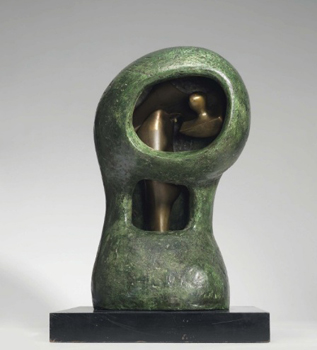Product Description
Otto Heintz / Heintz Art Metal Shop Grand verdigris “Silver Crest” vase c. 1925-30


OTTO HEINTZ, New York
HEINTZ ART METAL SHOP Buffalo, New York
Grand verdigris “Silver Crest” vase c. 1925-30
Bronze with a rich green patina; sterling silver collar and foot
Made by the Heintz Art Metal Shop, Buffalo, NY
Marks: Silver Crest logo with STERLING DECORATED BRONZE, conjoined H A M S in diamond shape, 1080
For further information see: The Arts & Crafts Movement in New York State: 1890s-1920s. Coy L. Ludwig (Hamilton, NY: Gallery Assoc. of NY State, 1983) p. 90.
H: 14 3/4”
The Heinz shop used sterling silver applied as floral ornamentation to bronze. The objects were distinguished by a variety of patinas and machine-shaped bases-very different from the hammered look of most Arts and Crafts metal works. Despite the death of its founder Otto Heinz in 1918 at the age of 41, the company continued and produced a more modern line entitled Silver Crest.
Otto Heintz / Heintz Art Metal Shop Grand verdigris “Silver Crest” vase c. 1925-30
TAPIO WIRKKALA (1915-1985) Finland
NILS WESTERBACK Finland
Pendant Necklace 1970
Lap-gold (18K gold or higher) pendant head with a rigid necklace
Makers: Tapio Wirkkala and Nils Westerback
Marks: 750, three crowns symbols
Model illustrated in: The Art of Jewelry, Graham Hughes (New York: The Viking Press, Inc., 1972), p. 135; Scandinavian Design, Charlotte and Peter Fiell (Köln: TASCHEN, 2002) p. 675; Marianne Aav, Rosa Barovier Mentasti and Gordon Bowyer, et al., Tapio Wirkkala – eye, hand and thought, exh. cat., Museum of Art and Design, Helsinki, 2000, p. 194, fig. 342 and p. 370
HAYNO FOCKEN (1905-1968) Germany
Round covered box c. 1935
Hand-wrought and hand-hammered copper with brass details
Marks under the foot: HF (conjoined monogram)
For other works by Hayno Focken see: Metallkunst: Vom Jugendstil zur Moderne (1889-1939), ed. Karl H. Bröhan (Berlin: Bröhan Museum, 1990), illus. 177, p. 183; Avantgarde Design 1880=1930,Torsten Bröhan & Thomas Berg (Köln, Benedict Taschen, 1994) p. 116; , (Berlin 1937) S. 43f, Abb. 37, Abb. S 128, S 146, Sl 243; Die Schaulade 15 Ausg. A (1939) Abb. S. 197, S. 204, S. 213; Die Schaulade 16 Ausg. A (1940) Abb. S. 44, S. 51., S. 54, S. 71, S. 83. S. 89; Die Kunst 84 (1941) S. 136, S. 139-39; Die Schaulade 17 (1941) Abb. S. 13, S. 41, S. 82, S. 229;
H: 4 ¼” x Dia: 4 7/8”
Hayno Focken (1905-1968) was an eminent German metal artist. He completed his training under Professor Karl Müller (1888-1972) at the design and arts school on Giebichenstein Castle in Halle (Saale), which was strongly tied to the ideals of the Deutsche Werkbund and the Bauhaus. In 1932 he established his own workshop in Lahr/Schwarzwald and continued his work until shortly before his death. His artistic work always stood out with a strong preference for large, organic forms, a similar manner of surface design and the same adherence to the principle of handicraft. Even his artist signet was modelled on the simple, square castle mark. In the 1950s he became one of those significant artists who had a major impact on contemporary metal design. The foundation of his creative work was a masterful understanding of proportions.
